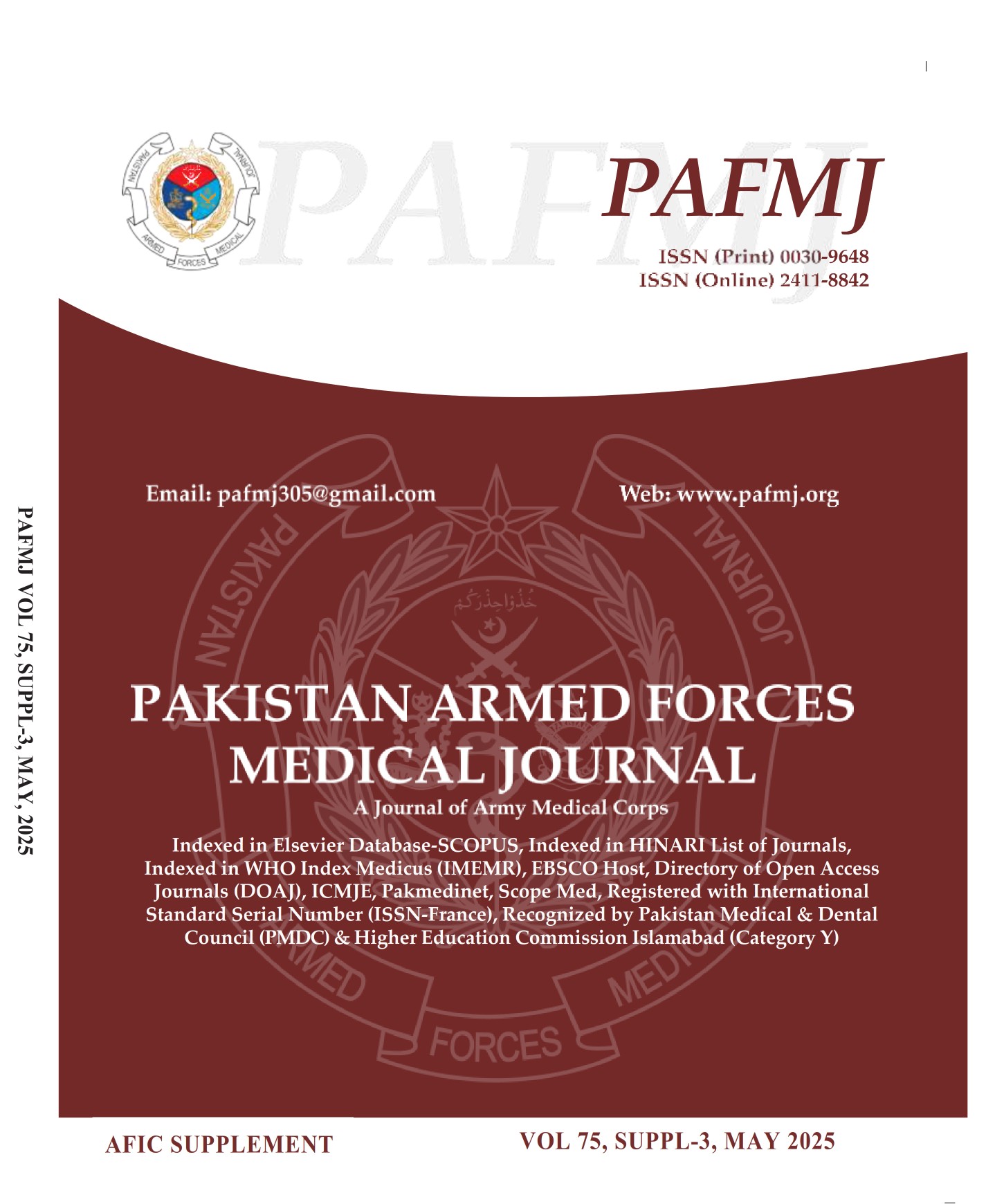Clinical and Biological Factors Affecting Left Ventricular End-Diastolic Pressure in ST-Segment Elevation Myocardial Infarction
DOI:
https://doi.org/10.51253/pafmj.v75iSUPPL-3.12776Keywords:
Biological factors, Clinical factors, Left ventricular end-diastolic pressure, Primary percutaneous coronary intervention, ST-segment elevation myocardial infarction.Abstract
Objective: To determine the clinical & biological factors affecting Left Ventricular End Diastolic Pressure(LVEDP) in ST-Segment Elevation Myocardial Infarction (STEMI) patients undergoing coronary angiography followed by Primary Percutaneous Coronary Intervention(PPCI).
Study Design: Quasi-Experimental study.
Place and Duration of Study: Armed Forces Institute of Cardiology/National Institute of Heart Diseases, Rawalpindi Pakistan, from Feb-Aug 2024.
Methodology: Ninety-six STEMI patients regardless of gender were enrolled through consecutive sampling. Baseline variables like Hs-Trop I, BMI, Ejection Fraction, Mean Arterial Pressure, and Killip Class were noted upon patient arrival at emergency room. LVEDP was measured using pigtail catheter during coronary-angiography and patients were classified non-randomly in two Groups: LVEDP<16mmHg (Group-A) and ≥16mmHg (Group-B). Coronary artery disease severity was assessed using the Gensini score. Clinical parameters and biological parameters were compared between Groups.
Results: Ninety-six patients [males: 66(68.8%), females: 30(31.2%)] with composite mean age 63.26±7.99 years were enrolled in study. For LVEDP, 51(53.1%) patients had values <16mmHg, while 45(46.9%) had LVEDP≥16mmHg. BMI was significantly higher in Group-B [30.00(24.00-34.00) kg/m² vs 24.00(22.00-26.00) kg/m²; p<0.001] and all the patients classified as Killip class III/IV had LVEDP≥16 mmHg (p<0.001). There was significant difference in mean values of Gensini score, EF, NT-proBNP, Hs Trop-I, MAP, TG and eGFR with comparatively higher mean values in Group-B patients except EF and eGFR (p<0.01). Correlation was significant between LVEDP and aforementioned clinical parameters except TRG (p<0.001).
Conclusion: LVEDP is strongly associated with higher BMI, advanced Killip class, and increased coronary artery severity. It also correlates with elevated cardiac biomarkers and reduced ejection fraction,..
Downloads
References
Roth GA, Mensah GA, Johnson CO, Addolorato G, Ammirati E, Baddour LM, et al. Global Burden of Cardiovascular Diseases and Risk Factors, 1990–2019: Update From the GBD 2019 Study. J Am Coll Cardiol 2020; 76(25): 2982-3021.
https://doi.org/10.1016/j.jacc.2020.11.010
Ahmad S, Sohail A, Chishti MAS, Azeem T. Prevalence of ST-segment elevation myocardial infarction (STEMI) in Pakistan and the role of Primary percutaneous coronary intervention (PPCI). Ann King Edw Med Univ 2022; 28(2): 259–267.
http://dx.doi.org/10.21649/akemu.v28i2.5119
Stephens NR, Restrepo CS, Saboo SS, Baxi AJ. Overview of complications of acute and chronic myocardial infarctions: revisiting pathogenesis and cross-sectional imaging. Postgrad Med J 2019; 95(1126): 439-450.
https://doi.org/10.1136/postgradmedj-2018-136279
Pagliaro BR, Cannata F, Stefanini GG, Bolognese L. Myocardial ischemia and coronary disease in heart failure. Heart Fail Rev 2020; 25(1): 53-65. https://doi.org/10.1007/s10741-019-09831-z
Zhou X, Lei M, Zhou D, Li G, Duan Z, Zhou S, et al. Clinical factors affecting left ventricular end-diastolic pressure in patients with acute ST-segment elevation myocardial infarction. Ann Palliat Med 2020; 9(4): 1834-1840.
https://doi.org/10.21037/apm.2020.03.22
Salem R, Denault AY, Couture P. Left ventricular end-diastolic pressure is a predictor of mortality in cardiac surgery independently of left ventricular ejection fraction. Br J Anaesth 2006; 97: 292-297.
https://doi.org/10.1093/bja/ael140
Ali S, Samore NA, Ahmed I, Khan MN, Alam F, Mustafa A, et al. Association of Acute Change in Left Ventricular End Diastolic Pressure with In-Hospital Mortality after Primary Percutaneous Coronary Intervention in Patients with ST Segment Elevation Myocardial Infarction. Pak Armed Forces Med J 2023; 73(3): 505-509.
https://doi.org/10.51253/pafmj.v73iSUPPL-3.10560
Nishimura RA, Carabello BA. Hemodynamics in the cardiac catheterization laboratory of the 21st century. Circulation 2012; 125(17): 2138-2150.
https://doi.org/10.1161/circulationaha.111.060319
Teixeira R, Lourenço C, Baptista R, Jorge E, Mendes P, Saraiva F, et al. Left ventricular end-diastolic pressure and acute coronary syndromes. Arq Bras Cardiol 2011; 97(2): 104-112.
https://doi.org/10.1590/S0066-782X2011005000074
Domienik-Karłowicz J, Kupczyńska K, Michalski B, Kapłon-Cieślicka A, Darocha S, Dobrowolski P, et al. Fourth universal definition of myocardial infarction: selected messages from the European Society of Cardiology document and lessons learned from the new guidelines on ST-segment elevation myocardial infarction and non-ST-segment elevation-acute coronary syndrome. Cardiol J 2021; 28(2): 195-201.
https://doi.org/10.5603/CJ.a2021.0036
Wang KY, Zheng YY, Wu TT, Ma YT, Xie X. Predictive value of Gensini score in the long-term outcomes of patients with coronary artery disease who underwent PCI. Front Cardiovasc Med 2022; 8: 778615.
http://dx.doi.org/10.3389/fcvm.2021.778615
Russo C, Jin Z, Homma S, Rundek T, Elkind MS, Sacco RL, et al. Effect of obesity and overweight on left ventricular diastolic function: a community-based study in an elderly cohort. J Am Coll Cardiol 2011; 57(12): 1368-1374.
https://doi.org/10.1016/j.jacc.2010.10.042
Lumori BAE, Nuwagira E, Abeya FC. Association of body mass index with left ventricular diastolic dysfunction among ambulatory individuals with diabetes mellitus in rural Uganda: a cross-sectional study. BMC Cardiovasc Disord 2022; 22(1): 279. https://doi.org/10.1186/s12872-022-02718-2
Suleman M, Saqib M, Mumtaz H, Iftikhar M, Raza A, Rauf Butt S, et al. Novel echocardiographic markers for left ventricular filling pressure prediction in heart failure with preserved ejection fraction (ECHO-PREDICT): a prospective cross-sectional study. Ann Med Surg 2023; 85: 5384-5395.
https://doi.org/10.1097/MS9.0000000000001287
Ndrepepa G, Cassese S, Hashorva D, Kufner S, Xhepa E, et al. Relationship of left ventricular end-diastolic pressure with extent of myocardial ischemia, myocardial salvage, and long-term outcome in patients with ST-segment elevation myocardial infarction. Catheter Cardiovasc Interv 2019; 93(5): 901-909. https://doi.org/10.1002/ccd.28098
Çap M, Erdoğan E, Karagöz. The association of left ventricular end-diastolic pressure with global longitudinal strain and scintigraphic infarct size in ST-elevation myocardial infarction patients undergoing primary percutaneous coronary intervention. Int J Cardiovasc Imaging 2021; 37: 359–366.
https://doi.org/10.1007/s10554-020-01945-y
Burak C, Çağdaş M, Rencüzoğulları I, Karabağ Y, Artac I, Yesin M, et al. Association of P wave peak time with left ventricular end-diastolic pressure in patients with hypertension. J Clin Hypertens 2019; 21(5): 608-615.
https://doi.org/10.1111/jch.13530
Solangi BA, Shaikh KA, Shah JA, Kumar R, Khan KA, Batra MK, et al. Left Ventricular End-Diastolic Pressure and Extent of Coronary Artery Disease in Patients Undergoing Primary Percutaneous Coronary Intervention. Pak Heart J 2023; 56(03): 231-237.
https://doi.org/10.47144/phj.v56i3.2481
Zhang S, Li JR. Serum NT-proBNP and TUG1 as novel biomarkers for elderly hypertensive patients with heart failure with preserved ejection fraction. Exp Ther Med 2021; 21: 1–6.
Downloads
Published
License
Copyright (c) 2025 Muhammad Wajid Sadiq, Muhammad Bilal Siddique, Shaheer Farhan, Iftikhar Ahmed, Riaz Haider, Malik Muhammad Khurram Shahzad

This work is licensed under a Creative Commons Attribution-NonCommercial 4.0 International License.















